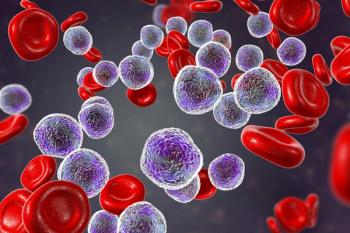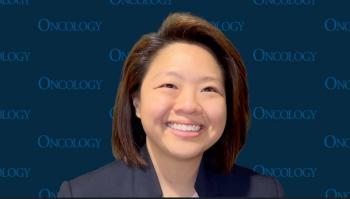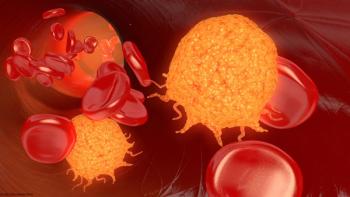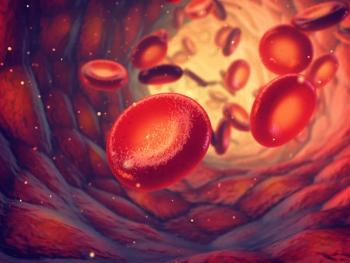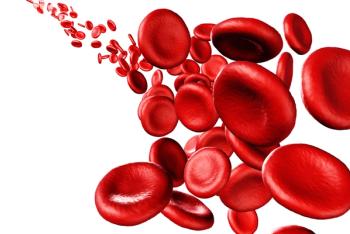
- ONCOLOGY Vol 15 No 3
- Volume 15
- Issue 3
Combination Fludarabine, Cyclophosphamide, and Rituximab for Previously Treated Patients With Chronic Lymphocytic Leukemia
Treatment options for patients with relapsed chronic lymphocytic leukemia (CLL) are limited. In this report, we present our preliminary results of a biochemotherapy combination using rituximab (Rituxan, a monoclonal antibody against CD20) with
Treatment options for patients with relapsed chronic lymphocyticleukemia (CLL) are limited. In this report, we present our preliminary resultsof a biochemotherapy combination using rituximab (Rituxan, a monoclonal antibodyagainst CD20) with fludarabine (Fludara) and cyclophosphamide (Cytoxan, Neosar).During course 1, rituximab is given at a slow rate at 375 mg/m2 on day 1followed by fludarabine at 25 mg/m2 and cyclophosphamide at 250 mg/m2 on days 2-4.During subsequent courses (2-6), rituximab is given at 500 mg/m2 on day 1 andfludarabine and cyclophosphamide are given at the same doses but on days 1-3.Of 84 patients registered, 43 are currently evaluable after more than 3 courses.
Patients had a median age of 57 years (range: 18 to 74 years),65.1% were male, and 44% were Rai stage IV. The median platelet count was 110(range: 15 to 367), median hemoglobin was 12.2 (range: 6.8 to 16.0), and medianwhite blood cell count was 45.8 (range: 2.7 to 311). Three or more lymph nodesites were involved in 58%, B2 microglobulin was greater than 3 in 79%, and 83%had a performance status of 1 or less. Of the 43 patients, 1 had spleniclymphoma with villous lymphocytes and 1 had marginal zone lymphoma. The mediannumber of prior treatments was 3: 9.3% of patients had received alkylatingagents only, 65.1% had been sensitive to fludarabine-containing regimens, and20.9% had been resistant to fludarabine. The median follow-up time is 5 months.
Using National Cancer Institute criteria, the complete remission(CR) rate is 14% (all in the fludarabine-sensitive group, 21%), nodular partialresponse (PR) 14%, PR 42%, stabilization of disease 4.7%, and no response 20.9%.Total response rate is 69.9%. One patient died early. Five other patients havedied (none during the first course), 3 of them due to progression of disease.Serious toxicities from the treatment include 8 episodes of pneumonia, 4episodes of neutropenic fever, 2 of sepsis, and 1 prolonged myelosupression.Other frequent toxicities related to rituximab include fever, chills, andnausea; hypotension occurred in 5 (12%) patients.
CONCLUSION: In summary, fludarabine, cyclophosphamide, andrituximab is a very active and well-tolerated program for patients withpreviously treated CLL, in particular for fludarabine-sensitive disease. Studiesevaluating the efficacy and toxicity of this program are ongoing.
Articles in this issue
almost 25 years ago
State of the Art of Non-Small-Cell Lung Cancer in the New Millenniumalmost 25 years ago
Novel Approaches in the Treatment of Non-Small-Cell Lung Canceralmost 25 years ago
Triplet Combination Chemotherapy and Targeted Therapy Regimensalmost 25 years ago
Gemcitabine and Nonplatinum Combinations in Non-Small-Cell Lung Canceralmost 25 years ago
Gemcitabine for the Treatment of Non-Small-Cell Lung Canceralmost 25 years ago
Gemcitabine in Combination With New Platinum Compounds: An Updatealmost 25 years ago
Treatment of Elderly Patients With Non-Small-Cell Lung Canceralmost 25 years ago
Optimizing Chemoradiation in Locally Advanced Non-Small-Cell Lung Canceralmost 25 years ago
Irinotecan in Gastrointestinal MalignanciesNewsletter
Stay up to date on recent advances in the multidisciplinary approach to cancer.


